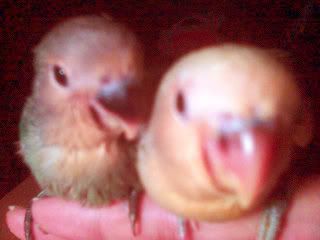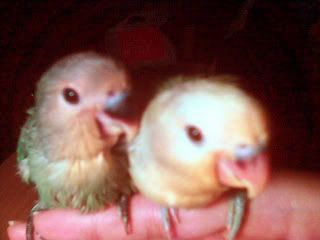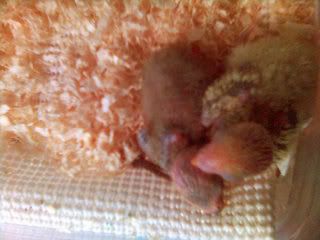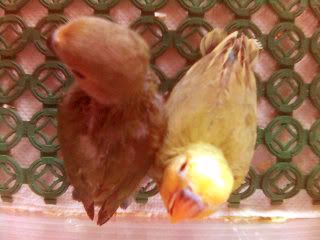






 Happy hatchday to the latest addition to the family! Now there are 3 of them. They kind of look like adorable naked molerats, don't they?
Happy hatchday to the latest addition to the family! Now there are 3 of them. They kind of look like adorable naked molerats, don't they? Last Saturday, we got 2 new hatchlings, coming out of their eggs a few hours apart. Both looked well and healthy. The third egg is starting to hatch (if you look closely, you will notice a small chip on the egg next to the more prominently seen chick). I used my phone camera to take this one so the photo resolution is not so good. I also took a short 17-second video.
Last Saturday, we got 2 new hatchlings, coming out of their eggs a few hours apart. Both looked well and healthy. The third egg is starting to hatch (if you look closely, you will notice a small chip on the egg next to the more prominently seen chick). I used my phone camera to take this one so the photo resolution is not so good. I also took a short 17-second video. Dr. Foster and Dr. Smith of the Veterinary & Aquatic Services Department had an interesting entry about bird behavior. They have a detailed description about the things birds do and what it means.
Dr. Foster and Dr. Smith of the Veterinary & Aquatic Services Department had an interesting entry about bird behavior. They have a detailed description about the things birds do and what it means. We checked the nestbox this morning to find a second egg. We're all very excited about it. The birds have been eating okra like crazy, which is good. We make it a habit to feed them greens and not just seeds.
We checked the nestbox this morning to find a second egg. We're all very excited about it. The birds have been eating okra like crazy, which is good. We make it a habit to feed them greens and not just seeds.
"Nails need to be clipped when they are becoming snagged on toys, cage covers or clothes. One can use a human nail clipper or baby nail scissors, and take off just the tippy-tips.
All nails have a blood supply. If you nick into this blood supply or quick, have some Quik-Stop or Stay on hand. If you do not have these commercial products on hand, flour or corn starch will work. Apply this with gentle pressure until the bleeding stops. Occasionally the nail gets cut too short and these products don't work. Silver nitrate sticks stop any bleeding. They are available from your avian veterinarian.
The proper size perch can help keep nails at the correct length. The tips of the nails should touch the perch. You can also use concrete perches, pedi-perches, sandy perches, hard wood perches or any of the other conditioning perches available today. Using a variety of perches also helps the bird stay comfortable since they are on their feet 24 hours a day, 7 days a week. It also helps to prevent early onset arthritis." (Source: NCS Magazine)
 Based on the text that I have read, we should get CAREFRESH to line the brooder with to avoid splayed legs, and to make sure that there is no build-up of bacteria in the brooder. PetSMART says that CAREFRESH is "the ideal pet bedding and litter for parakeets, finches, cockatiels, conures, parrots, macaws and all other birds." Apart from providing superior odor control, CAREFRESH is highly absorbent, natural and biodegradable. It comes in many variants, all of which are non-toxic and pet-safe. It contains no contaminants, added inks, dyes, or chemicals. Made of natural, biodegradable wood pulp fiber, CAREFRESH is sanitized to kill bacteria, mold and fungus. Its natural, biodegradable fiber allows for safe and easy disposal. Heck, some even say that it's flushable (but I'd rather not disprove this theory firsthand).
Based on the text that I have read, we should get CAREFRESH to line the brooder with to avoid splayed legs, and to make sure that there is no build-up of bacteria in the brooder. PetSMART says that CAREFRESH is "the ideal pet bedding and litter for parakeets, finches, cockatiels, conures, parrots, macaws and all other birds." Apart from providing superior odor control, CAREFRESH is highly absorbent, natural and biodegradable. It comes in many variants, all of which are non-toxic and pet-safe. It contains no contaminants, added inks, dyes, or chemicals. Made of natural, biodegradable wood pulp fiber, CAREFRESH is sanitized to kill bacteria, mold and fungus. Its natural, biodegradable fiber allows for safe and easy disposal. Heck, some even say that it's flushable (but I'd rather not disprove this theory firsthand). According to aviary owner, Amanda Stoner from Canada, "the first egg is laid within 10 days after mating. The lovebirds eggs are laid in the nest every other day. The hen usually starts to brood (sit on the eggs) after the second egg is laid. Most of the time, the eggs are laid at night. Brooding takes 22 to 25 days."
According to aviary owner, Amanda Stoner from Canada, "the first egg is laid within 10 days after mating. The lovebirds eggs are laid in the nest every other day. The hen usually starts to brood (sit on the eggs) after the second egg is laid. Most of the time, the eggs are laid at night. Brooding takes 22 to 25 days."You know it when you see it: a poor chick's legs are spread straight out from the body and the chick is unable to get a grip and sit up with its legs properly underneath its body. Splay legs can be very traumatic for the novice breeder. The best way to deal with this is to prevent it. Even the best nest-builders should be given a basic substrate for the nest box. I recommend Care Fresh. It is nontoxic and easy to get. Put about 2-3 inches into the nest box. Then give the hen nest-building materials. She will build her nest on top of the substrate. This prevents the chicks from ending up on the bottom of a nestbox on a slippery wooden floor where they can't get a proper grip. It also cushions them if they have an overzealous mother who sits very tightly on them. If you've already got chicks in the nest and realize they are hitting the wooden floor, remove chicks, remove the nest built by the mother (try to keep it basically intact), add 2-3 inches of Care Fresh, replace mother's nest on top of the substrate, replace chicks. Problem solved. If you've got some babies with splay legs, the best way to treat it is to double band the legs, use dental floss to tie the legs together in the proper position under the body, place the baby in a cushioned cup to help hold it in the proper position. Obviously this entails pulling the baby from the nest and handfeeding it separately from other chicks, as the string between the legs can strangle other chicks in the nest. If you are having difficulty, take the baby to the vet. You do not want to let this go, as these birds are often severely crippled and will need special caging and extra help all their lives. (Source: Parrot Parrot)I've been researching since day 1 so that we could prepare ourselves to handfeed the chicks when they hatch. I've never done it before, but my husband has had some experience in it. He has handfed 3 chicks, and they turned out pretty well, so I'm pretty optimistic.








